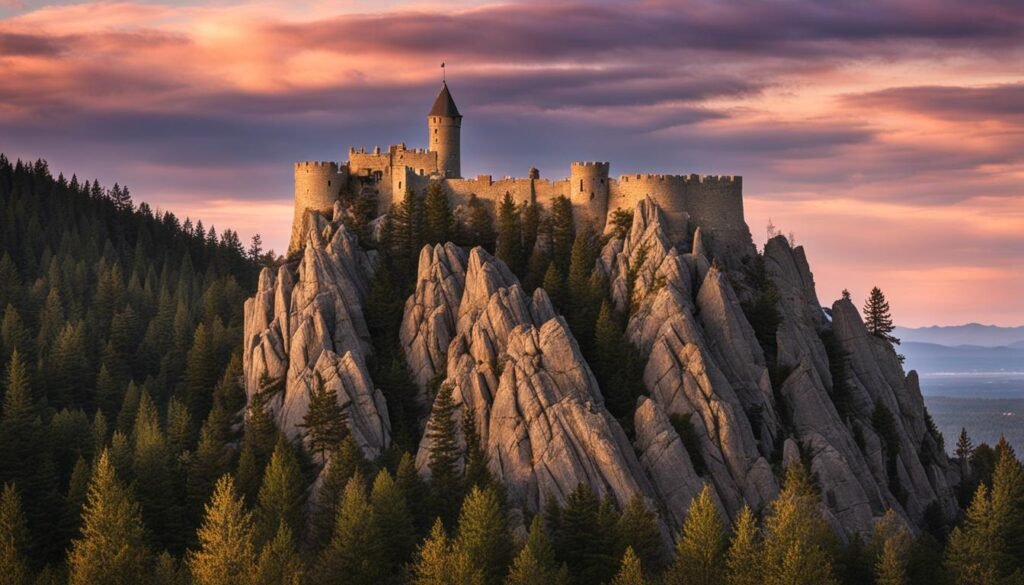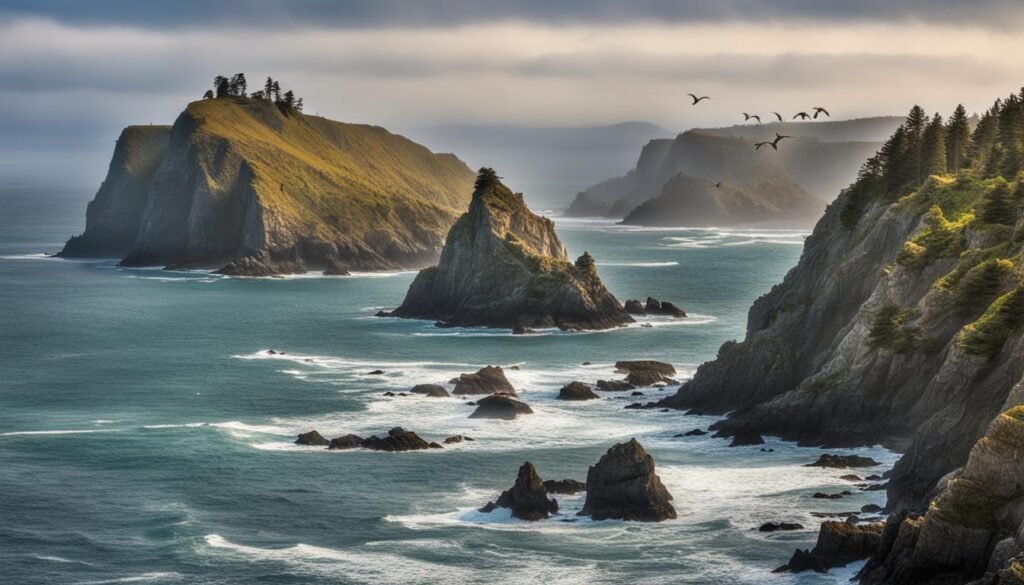Welcome to the Castle Rock National Wildlife Refuge, an extraordinary sanctuary for seabirds, marine mammals, and diverse wildlife located off the coast of Crescent City, California. Spanning an impressive 14 acres, this refuge serves as a vital habitat for hundreds of thousands of animals, including harbor seals, northern elephant seals, sea lions, and numerous avian species. As an integral part of the California Marine Protected Area Network, the refuge plays a crucial role in conserving and protecting our precious marine ecosystems.
Key Takeaways:
- Castle Rock National Wildlife Refuge is located off the coast of Crescent City, California.
- The refuge covers an area of 14 acres and is home to a wide range of seabirds, marine mammals, and other wildlife.
- The refuge is closed to the public to ensure the undisturbed habitat for animals.
- Castle Rock is an important breeding ground for endangered species, such as the Aleutian cackling goose.
- Visitors can observe the diverse wildlife from the interpretive panel overlook in Crescent City.
Location and Contact Information
Castle Rock National Wildlife Refuge is located approximately half a mile offshore from Crescent City, California. As you visit Crescent City, you can access the refuge from Pebble Beach Drive. From there, you’ll find an interpretive panel overlook that provides breathtaking views of Castle Rock Island and its abundant wildlife.
If you want more information about the refuge and its conservation efforts, I recommend visiting the website of the California Department of Fish and Wildlife. They provide comprehensive details about Castle Rock National Wildlife Refuge, including updates on activities and initiatives.
Visiting Castle Rock National Wildlife Refuge offers a unique opportunity to appreciate the beauty and diversity of nature in the pristine coastal environment of Crescent City, California.
History and Geology of Castle Rock
Castle Rock, located off the coast of Crescent City, has a captivating history and unique geology that add to its allure. The island’s story dates back centuries when the Tolowa people utilized it for foraging purposes. Although the Tolowa did not inhabit the island permanently, they recognized its abundant resources, including the surrounding marine life.
Over time, Castle Rock’s ownership changed hands, eventually falling under the control of the U.S. Government. It served various functions, such as grazing sheep and guano mining. However, the significance of Castle Rock as a habitat for marine mammals and seabirds prompted the U.S. Fish and Wildlife Service to acquire the island in 1979.
The geology of Castle Rock is mesmerizing, comprising pillow basalt, shale, and greywacke. Wave erosion has shaped the island’s rocky shoreline, resulting in the formation of intriguing sea caves and other geological wonders. This harmonious blend of history and geology makes Castle Rock a captivating destination.

Fish Castle: A Natural Wonder
One of the standout features of Castle Rock is its fish-shaped rock formation, aptly named Fish Castle. This remarkable geological formation adds to the island’s allure and serves as an iconic symbol. Visitors can marvel at this natural wonder, a testament to the power of nature’s creativity.
Resolute and Majestic: Castle on Rock
Perched proudly on its rocky foundation, Castle Rock stands tall and regal. Its prominence in the coastal landscape makes it a landmark worth admiring. The striking image of the castle on the rock is a sight to behold, inspiring a sense of awe and wonder.
Wildlife at Castle Rock National Wildlife Refuge
Castle Rock National Wildlife Refuge is a haven for wildlife enthusiasts, offering a diverse range of species and breathtaking natural beauty. Located off the coast of Crescent City, California, this wildlife refuge is a paradise for birdwatching and nature lovers.

As the second-largest nesting seabird colony south of Alaska, Castle Rock is a hotspot for bird activity. With approximately 150,000 seabirds utilizing the island, visitors can witness the mesmerizing sight of these graceful creatures in their natural habitat. The refuge also serves as a crucial breeding ground for harbor seals and northern elephant seals, providing a safe environment for their reproduction and survival.
Castle Rock is also home to other fascinating wildlife, including sea lions, shorebirds, and cetaceans such as harbor porpoises and gray whales. Exploring the refuge’s ecosystem offers a unique opportunity to observe these magnificent animals in their native surroundings.
Furthermore, Castle Rock National Wildlife Refuge plays a vital role in the conservation of endangered species. One notable resident is the Aleutian cackling goose, which relies on the refuge’s protected habitat for survival. Through the refuge’s efforts, this species and others are given a chance to thrive and recover their populations.
Whether you’re an avid birdwatcher or simply appreciate the wonders of the natural world, Castle Rock National Wildlife Refuge is a must-visit destination. Immerse yourself in the beauty of this wildlife sanctuary, and witness firsthand the incredible diversity of species that call it home.
Conclusion
Castle Rock National Wildlife Refuge offers a unique opportunity to immerse yourself in the stunning beauty and extraordinary biodiversity of nature. Although the refuge is not accessible to the public, you can still observe the captivating wildlife from the interpretive panel overlook located in Crescent City. This conservation area plays a vital role in protecting and preserving wildlife, serving as a sanctuary for numerous endangered species.
For outdoor enthusiasts, Castle Rock National Wildlife Refuge is a haven for engaging in activities that celebrate the wonders of nature. Birdwatching enthusiasts can marvel at the diverse avian species that call this refuge their home. Nature photography enthusiasts will be captivated by the incredible opportunities to capture breathtaking images of wildlife and scenic views along the stunning coastline.
By cherishing the natural beauty of Castle Rock National Wildlife Refuge, we contribute to the ongoing efforts of wildlife conservation and the preservation of precious ecosystems. This refuge symbolizes the importance of safeguarding our planet’s biodiversity and serves as a reminder of the awe-inspiring wonders that nature bestows upon us.
FAQ
Can the public visit Castle Rock National Wildlife Refuge?
No, the refuge is closed to the public to prevent disturbance to the wildlife.
How can I view the wildlife at Castle Rock?
Visitors can view the wildlife from the interpretive panel overlook in Crescent City, located on Pebble Beach Drive.
What is the history of Castle Rock?
Castle Rock has a rich history dating back to the Tolowa people who foraged on the island. It was later used for grazing sheep and mining guano before being purchased by the U.S. Fish and Wildlife Service.
What is the geology of Castle Rock?
The geology of Castle Rock consists of pillow basalt, shale, and greywacke. Wave erosion has created sea caves and unique formations.
What wildlife can be found at Castle Rock National Wildlife Refuge?
Castle Rock is home to a diverse range of wildlife, including seabirds, harbor seals, northern elephant seals, sea lions, shorebirds, and cetaceans such as harbor porpoises and gray whales. It is also an important habitat for endangered species like the Aleutian cackling goose.
Can I engage in birdwatching and nature photography at Castle Rock?
While the refuge is not open to the public, visitors can still engage in birdwatching and nature photography from the interpretive panel overlook in Crescent City.







